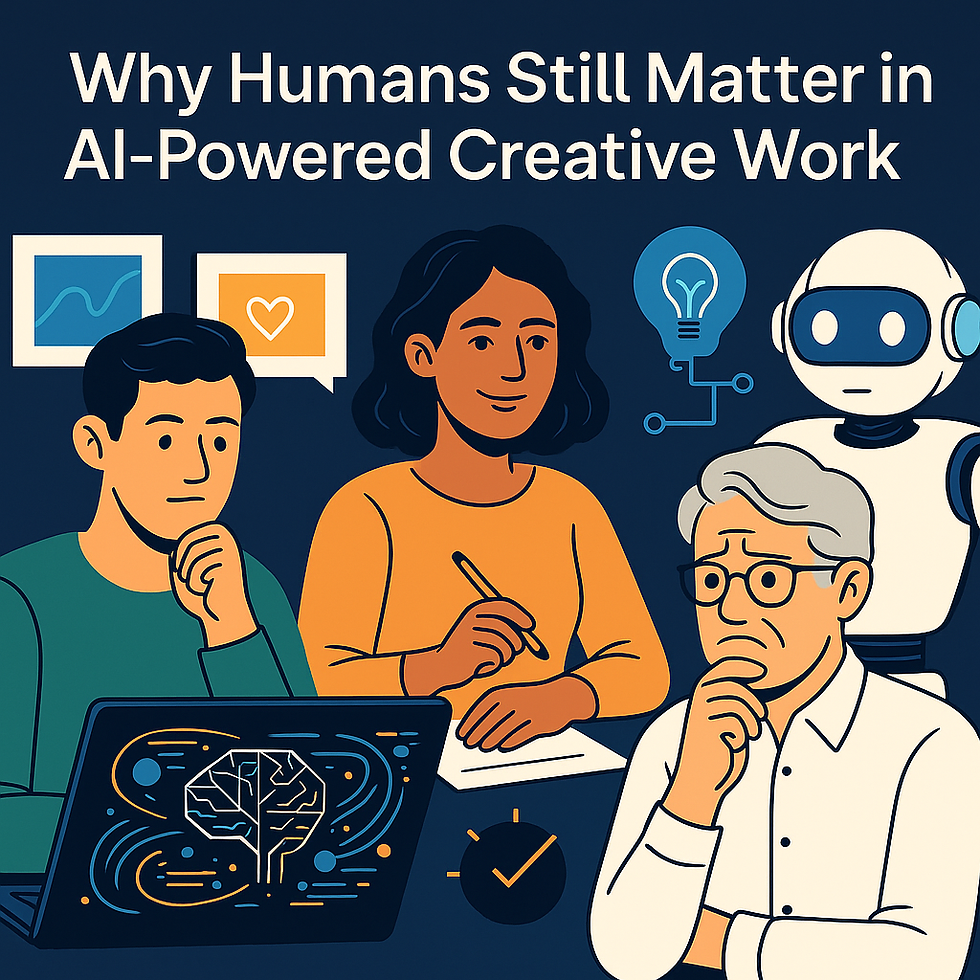AI and the Future of Video Production: What’s Actually Possible in 2025
- pragyasax
- Aug 6
- 3 min read
AI video is everywhere — in startup decks, in agency pitches, in your feed. But what can it actually do? And more importantly, what does it still need you for?

At Kaizen, we work at the intersection of creativity and automation. We use AI tools across scripting, editing, asset generation, and localization — not as a replacement for creative direction, but as an amplifier for speed, scale, and impact.
This post breaks down what AI can really do in video production as of August 2025, where it's going, and how to work with it instead of around it.
1. Script Generation and Narrative Structure
AI models like LLaMA 3 (Meta), GPT-4o (OpenAI), and Claude 3 (Anthropic) are now fully capable of:
Drafting first-pass scripts based on tone, audience, and context
Rewriting or reformatting long content into social snippets, training modules, or explainers
Suggesting visual transitions, title cards, and scene structure
Supporting multilingual scripting with localization-aware tone adjustment
Pro Use:Pair AI with a structured prompt framework (e.g. [persona] + [purpose] + [emotion]) to generate scripts that aren’t just grammatically clean, but actually on-brand.
2. Editing and Assembly
Tools like Descript, Runway, Pika Labs, Adobe Firefly, and Meta’s internal systems now support:
Automated multi-cam editing using transcript-aligned cues
B-roll insertion based on scene descriptions or keywords
Speech cleanup (uhs, ums, stutters), audio leveling, and silence removal
Branded subtitles generated and stylized from script or transcript
Motion graphics from text or logo prompt inputs
Pro Use:Use AI to automate the tedious stuff (cuts, pacing, subtitles), then reserve human energy for moments that need nuance — transitions, comedic timing, pacing shifts, etc.
3. B-Roll and Visual Asset Generation
Using GenAI video models like Runway Gen-3, Pika Labs, and Sora (in limited preview), teams can now:
Generate short clips based on abstract prompts (e.g. “a confident woman walking through a clean office in soft light”)
Create stylized metaphors for concepts like “growth,” “security,” or “alignment”
Build looping visual environments or texture overlays
Replace static backgrounds in postproduction with AI-matched settings
⚠️ Limitations:
Realism can vary — GenAI still struggles with hands, faces, and fine motion at times
Diversity and representation must be manually enforced — bias in training data persists
Lighting and spatial continuity are difficult to match with real-world footage
Pro Use:Use AI b-roll not as filler, but as intentional rhythm breaks or metaphoric punches — and always direct the model with toneboards and brand guidelines in hand.
4. Voice + Avatar Generation
AI tools like ElevenLabs, HeyGen, Synthesia, and Meta’s voice model research now allow:
Realistic voice cloning (with permission), enabling brand-consistent narration at scale
Text-to-speech with emotional tuning (e.g. “encouraging,” “neutral,” “authoritative”)
Lip-synced avatar generation for training, onboarding, or language localization
Real-time dubbing across multiple languages with voice preservation
Pro Use:Use cloned voiceovers to streamline revisions and reduce reshoots — but pair them with ethics guardrails around consent, tone, and transparency.
5. Personalization, Localization, and Modularity
AI now makes it feasible to generate multiple versions of the same video, tailored by:
Department (e.g. legal vs. product vs. HR)
Region or language
Tone or urgency level
Viewer role (manager vs. IC)
This is achieved using:
Script modularity + AI cutdowns
Scene swaps + language swaps
Smart asset tagging + prompt-based reassembly
Pro Use:Use AI to scale production without scaling burnout. A 5-minute compliance video can now become 12 regionalized micro-videos with minimal manual effort — while keeping a consistent visual voice.
So What’s the Catch?
AI speeds things up — but it still needs:
Creative direction
Taste and pacing
Visual consistency and polish
Ethical filters and narrative integrity
It’s not “AI vs. creative.” It’s AI with creative.
And the best creative teams — the ones shipping brand-safe, emotionally resonant, high-volume content — are the ones who know how to direct the machine.
Final Thoughts
AI is no longer the future of video. It’s the present production stack. But what separates noise from brilliance is what you do with the tools.
At Kaizen, we use AI not to replace our creative instincts — but to empower them. We move faster, scale smarter, and stay more aligned with brand and audience than ever before.
If you’re looking to do the same, let’s talk. Or better yet — let’s build.



Comments